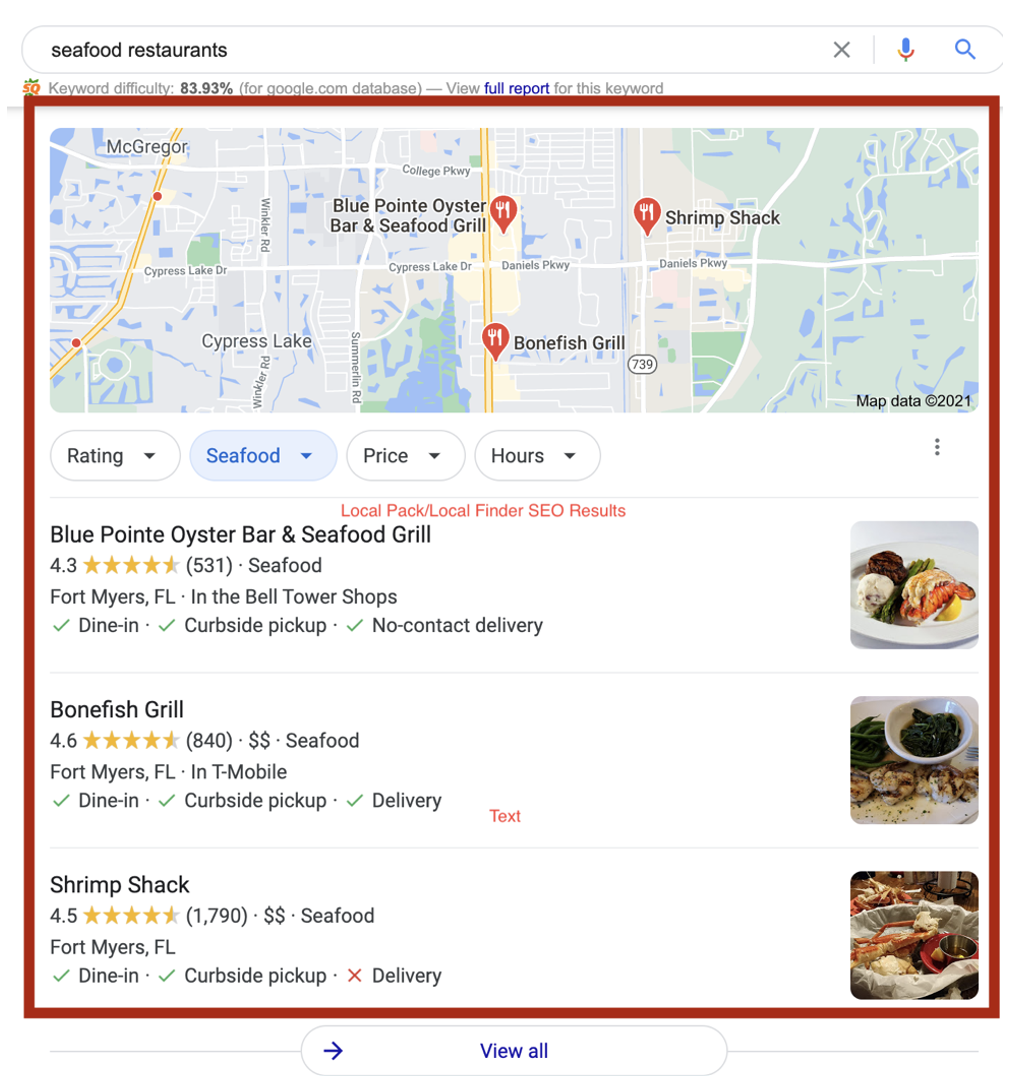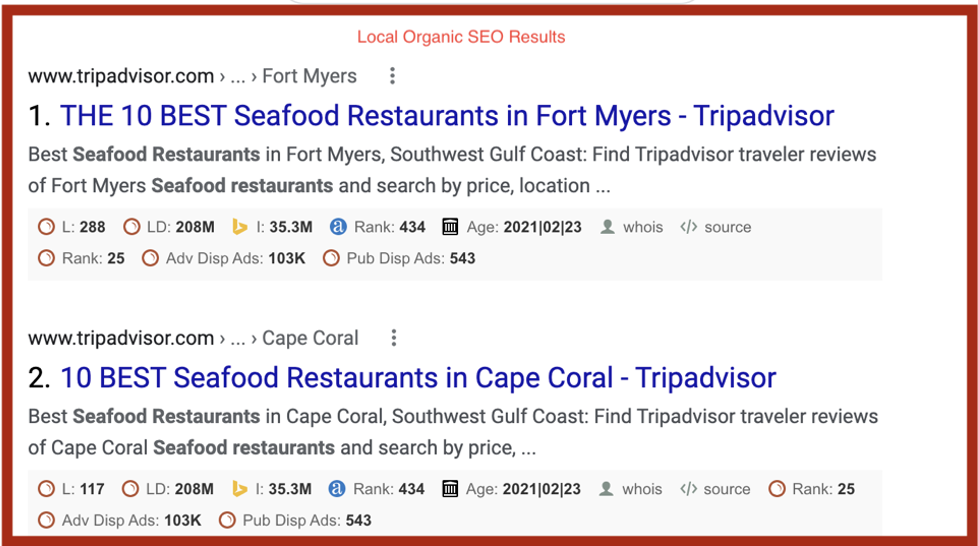How to Drive More Website Visitors and Generate More New Business Leads Using SEO
Business owners, managers, and marketers that expect their website to generate new leads from prospective customers often ask us how to improve their Google rankings in local search results. While many factors influence how Google ranks your website for different keywords, implementing a few of the critical factors explained in this post can make a substantial improvement in your local rankings, fast. That means, more traffic to your website, and better-qualified traffic, too.
There are two distinct types of local search results on Google.
- Local Pack/Local Finder and
- Local Organic results.
Local Pack/Local Finder Search SEO
The picture below shows how and where the Local Pack/Local Finder search results appear on Google.
Our experience shows that getting to the top of Local Pack/Local Finder rankings depends on setting up your Google My Business account correctly. Getting to the top of Local Pack/Local Finder and Local Organic search results depends on how well you actively manage your on-page optimization.

LOCAL PACK/LOCAL FINDER RESULTS
NOTE: The 3-pack doesn’t always display. Sometimes a 1-pack will show, and sometimes there is no display.

LOCAL ORGANIC RESULTS
HOW to GET a TOP 3 RANKING in LOCAL PACK/LOCAL FINDER
Google My Business is the key to a top 3 ranking in Local Pack/Local Finder. Google My Business provides a free service that allows for businesses and organizations to share information about your business location, hours of operation, services, and more. You need to claim and verify your business on Google My Business. Be sure to edit and manage your online business information across Google’s search and maps platform, too.
Updating Your Google My Business Listing
1. Login to your Google account. (Generally, this requires a Gmail email account.)
2. To find your business, do a Google search of your business or service category by area. If located, click on the Google Local listing, generally found under the map.
a. If you have access to edit it, you will see a link to “Manage your Business Profile.”
b. If you don’t already have access to update the Google My Business listing, you will see a link to “Own this Business?” You will have to verify your ownership via a phone call or postcard confirmation process.
c. If there is no business listing, click here https://business.google.com/create and follow the process to create a new listing.
3. Once you have located your listing and have access, add or review all the details. Verify the details are correct. (Everything is vital, including the correct business name, address, business category. Check it all carefully and make sure the listing is as complete as possible.)
What’s Really Important?
Ensure your business name, address, and phone number are exactly the same in Google My Business, as it is on your website and in other directory listings. Don’t abbreviate street in one place and spell it out in another. They need to match exactly.
Keywords in Google reviews, high Google ratings, and quantity of Google reviews with text are critical ranking factors. If you don’t have many reviews, reach out to your current, extremely satisfied customers and ask them to review you on Google.
Keep your listing up to date and refresh content regularly.
HOW to GET a FIRST PAGE RANKING in LOCAL ORGANIC RESULTS
On-page Search Optimization is the key to a first page ranking in Google’s Local Organic search results. Your site should contain the information that people searching for your businesses’ products or services want to find.
We’ve traced the reason why on-page search optimization matters so much to your Google Local Organic search ranking. That reason ties directly to Google’s mission statement, which is to organize the world’s information and make it universally accessible and useful.
A great user experience depends on great content that’s well-organized. By actively managing your on-page optimization to provide better content that’s better-organized than your competitors website, you help Google achieve its mission by delivering a great user experience. This is what helps your website rank well.
Caution:
If you are doing DIY SEO, don’t fall prey to “black hat” SEO tactics. While you might get a quick improvement in rankings, it is never a good idea to try to outsmart Google. It isn’t worth it because if you get caught, you may never rank again. Black hat tactics have caused businesses to go out of business.
On-Page Search Optimization Helps Your Local Pack/Local Finder Ranking, too.
Your website content sends signals to Google about what your business does and accounts for about 15% of local pack ranking factors.
What is the Minimum SEO to do?
1. Include the business name, address, phone number, keywords in the meta description, titles, and headlines on every page.
2. Identify the keyword focus of each page. Think about what words people use to search for your service. Utilize a keyword search tool to do your homework and check variations of the keywords to determine if you can get a higher volume/lower competition variation of the search terms. For example, I call that thing I sit on and watch TV in my den a couch, but twice as many people call it and search for a sofa. So, you better call it a sofa on your website. Keyword research will help define your keyword strategy.
3. Utilize variations of the focus keyword in the meta description, title tag, and headlines (H1, H2, etc.).
4. Try to use your city’s name in two spots on your website pages.
5. Remember, content is king. Be an authority on the subject. The more information you can provide, the higher the chance of improved ranking success.
6. If you want to compete for higher visibility in local search rankings, focus on creating content about your city or local area on your website’s pages.
7. If your business has more than one location, create a separate, localized web page for each. Don’t forget to include the business name, address, phone number, office hours, contact details, etc., on each page.
8. Most importantly, keep copious notes on your changes and track your results. If you do damage your rankings, you need to know what to undo. If you see a nice increase, you will want to do more of that!
Tracking SEO Results
When you conduct a Google search, you usually see personalized suggestions based on your location, the device you’re using, your past search/browsing history, and more. For example, if you have visited a website often (like your own to see how you’re ranking), that website may show up higher in your personalized results. You will think it is ranking well, but it’s only ranking for your search in reality.
If you search for a local business, like “Seafood restaurants,” Google will generally show you restaurants near you because it thinks this will be more relevant for your search. The same is not true for inquiries like “How to fix a faucet?” Typically, Google will display the best websites providing that information.
If you are checking manually and not using a service to track results, either use Chrome’s incognito window or add “&pws=0” after the search query string in your browser to see how you are ranking.
Google Analytics also provides useful insight into increased performance. For a baseline, compare the number of visits versus the same time last year and % of total visits via Google organic month over month.
Google Console provides deep insights into SEO metrics.
The Bottom Line
Doing your keyword research homework, executing flawlessly, and tracking results are critical in winning against your competitors and improving your search engine rankings. It’s not a set it and never look at it again type thing… There are always businesses out there competing for better rankings, so you need to work your SEO and track it actively. Don’t wake up one day and realize your website is ranking on the 10th page, and your traffic has gone away.
And of course, there is a less time-consuming way to improve your ranking… hire experts! To learn about Quenzel Marketing Agency’s SEO services or for a free website assessment, contact Earl Quenzel at 239-226-0040.





